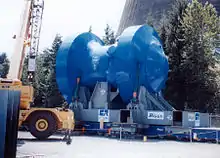تفكيك السلاح النووي
نزع السلاح النووي هو العملية التي يتم بموجبها تفكيك منشأة نووية إلى درجة أنها لم تعد تتطلب اتخاذ تدابير للحماية من الإشعاع.[1] يتطلب وجود المواد المشعة عمليات تنطوي على مخاطر محتملة ومهنية ومكثفة زمنياً وموجودة في البيئة ويجب التعامل معها لضمان نقل المواد المشعة إلى أماكن أخرى للتخزين أو تخزينها في الموقع بطريقة آمنة.[2] إن التحدي في وقف السلاح النووي ليس تقنيا فقط بل اقتصادي واجتماعيا.[3]


عملية نزح السلاح
تتم عملية الإيقاف إداريا وفنيا. ويشمل تنظيف المواد المشعة والهدم التدريجي للمنشأة.[4] بمجرد أن يتم إيقاف تشغيل المرفق بالكامل ، لا ينبغي أن يستمر أي خطر إشعاعي. تنتشر تكاليف إيقاف التشغيل عمومًا على مدى عمر المنشأة ويتم حفظها في صندوق خاص لذلك .[5] بعد إيقاف تشغيل المنشأة بالكامل يتم تحريرها من الرقابة التنظيمية ولم يعد المرخص له مسؤولاً عن سلامته النووية. قد تستمر عملية الإيقاف إلى الوضع «الأخضر».[6]
خيارات التفكيك
- يسمح التفكيك الفوري بإزالة المنشأة من الرقابة التنظيمية بعد إيقاف التشغيل. تبدأ أنشطة التفكيك أو التطهير النهائية في غضون بضعة أشهر أو سنوات ، وبناءً على المرفق قد يستغرق الأمر خمس سنوات أو أكثر بعد إزالته من الرقابة التنظيمية و يصبح الموقع متاحًا للاستخدام غير المقيد.[7]
- ينطوي على حسب وضعية المرفق في حالة تسمح للمواد المشعة بالبقاء في الموقع إلى أجل غير مسمى.[8] إن حجم المنطقة التي توجد فيها المادة المشعة يقل بشكل عام ويتم تغليف المرفق في مادة طويلة العمر مثل الخرسانة بهدف منع إطلاق المواد المشعة.[9]

الجوانب القانونية
لا يمكن وقف تشغيل المفاعل النووي إلا بعد منح الترخيص المناسب عملاً بالتشريعات ذات الصلة.[10] كجزء من إجراءات الترخيص حيث يجب كتابة مختلف الوثائق والتقارير وآراء الخبراء وتسليمها إلى السلطة المختصة على سبيل المثال:
- تقرير السلامة
- الوثائق التقنية
- دراسة التأثير البيئي
التعاون الدولي
ويشمل المنظمات التي تشجع على المشاركة الدولية للمعلومات والمعرفة والخبرات المتعلقة بإيقاف التشغيل النووي مثل الوكالة الدولية للطاقة الذرية ووكالة الطاقة النووية التابعة لمنظمة التعاون الاقتصادي والتنمية والمجموعة الأوروبية للطاقة الذرية.[11]
المراجع
- Benjamin K. Sovacool. "A Critical Evaluation of Nuclear Power and Renewable Electricity in Asia", Journal of Contemporary Asia, Vol. 40, No. 3, August 2010, p. 373.
- Invernizzi, Diletta Colette; Locatelli, Giorgio; Brookes, Naomi J. (2017-08-01). "How benchmarking can support the selection, planning and delivery of nuclear decommissioning projects". Progress in Nuclear Energy. 99: 155–164. doi:10.1016/j.pnucene.2017.05.002.
- Invernizzi, Diletta Colette; Locatelli, Giorgio; Brookes, Naomi J. (2017-10-01). "Managing social challenges in the nuclear decommissioning industry: A responsible approach towards better performance". International Journal of Project Management. Social Responsibilities for the Management of Megaprojects. 35 (7): 1350–1364. doi:10.1016/j.ijproman.2016.12.002.
- https://www.nrc.gov/reading-rm/doc-collections/fact-sheets/decommissioning.html Quote: Before a nuclear power plant begins operations, the licensee must establish or obtain a financial mechanism – such as a trust fund or a guarantee from its parent company – to ensure there will be sufficient money to pay for the ultimate decommissioning of the facility. نسخة محفوظة 2021-05-03 على موقع واي باك مشين.
- DECON: a method of decommissioning, in which structures, systems, and components that contain radioactive contamination are removed from a site and safely disposed at a commercially operated low-level waste disposal facility, or decontaminated to a level that permits the site to be released for unrestricted use shortly after it ceases operation.
- SAFSTOR: a method of decommissioning in which a nuclear facility is placed and maintained in a condition that allows the facility to be safely stored and subsequently decontaminated (deferred decontamination) to levels that permit release for unrestricted use.
- ENTOMB: a method of decommissioning, in which radioactive contaminants are encased in a structurally long-lived material, such as concrete. The entombed structure is maintained and surveillance is continued until the entombed radioactive waste decays to a level permitting termination of the license and unrestricted release of the property. During the entombment period, the licensee maintains the license previously issued by the NRC.
- Heuel-Fabianek, B., Kümmerle, E., Möllmann-Coers, M., Lennartz, R. (2008): The relevance of Article 37 of the Euratom Treaty for the dismantling of nuclear reactors. atw – International Journal for Nuclear Power 6/2008 Archived September 11, 2008, at the Wayback Machine.
- NRC Factsheet Decomissoning Quote: Before a nuclear power plant begins operations, the licensee must establish or obtain a financial mechanism – such as a trust fund or a guarantee from its parent company – to ensure there will be sufficient money to pay for the ultimate decommissioning of the facility.
- European Bank for Reconstruction and Development: Breakthrough for Chernobyl nuclear decommissioning efforts (Consortium Novarka to build New Safe Confinement Holtec International to complete Spent Fuel Storage) Archived August 21, 2008, at the Wayback Machine.
- With Exelon's Zion 1 and 2 reactors (2 x 1098 MWe) closed down in 1998 and in Safstor, a slightly different process is envisaged, considerably accelerating the decommissioning. Exelon has contracted with a specialist company – EnergySolutions, to remove the plant and return the site to greenfield status. To achieve this, the plant's licence and decommissioning funds will be transferred to EnergySolutions, which will then be owner and licensee, and the site will be returned to Exelon about 2018. Used fuel would remain on site until taken to the national repository.
- بوابة أسلحة
- بوابة الولايات المتحدة
- بوابة تقانة نووية
- بوابة طاقة
- بوابة طبيعة
- بوابة علم البيئة